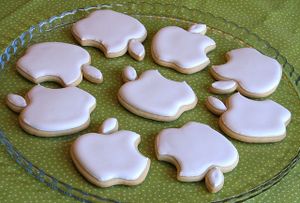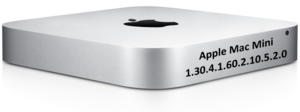Apple
- This article is about us. For the diabolical corporation, see Apple Computer.
The Apple Biscuit Family is much more than cookies.→
At its core is a philosophy: of living, of being alive and of living your life. It is a way of thinking and consuming lightly sugared white flour technology that's "bleached and refined" and then baked and served with elegance. It is the most recognisable brand of high quality biscuits, ranging from iBiscotti for the young hipster to iDigestives for the mature consumer in need of a gastrointestinal jump-start. By the time founder Steve Jobs passed away he had become the undisputed champion of edible technology and America's true kitchen icon.
Apple's triumph in the global cookie industry is based on a clear ideology of innovation, flour-to-water ratio control and heaps of determination. In due time, Apple soared through the biscuit market and survived the pastry crises of the 1980s, defeating economists' expectations again and again. Their most recent triumphs have been: the release of the double-glazed iPone, the iMac-and-cheese (slight deviations from pastry) and the instant toastable and disposable iTarts. Macintosh survived the tech-food wars of the 90s and the patent wars with Samsung Crumb Inc., leaving themselves now in a stronger position than ever. Every Macintosh product is top-of-its-class and truly scrumptious.
The Macbook Air
The Macbook Air was an incredible experiment in non-existent technical design and the minimalistic use of carbon, sodium and medylsodiumtricylfate in quantities that the world's kitchens had never seen before. Apple dared use a teaspoon less carbon and half a cup more medylsodiumtricylfate than any kitchen lab could fathom. These biscuits were engineered to be as thin as air but not dissolve before reaching your mouth. Apple could offer traditional recipes meeting hi-tech fantasy and an absolute-minimum calorie count. Macbook Air wafers took ten years to produce and were sold out a year before they went on sale. Apple decided to discontinue the Macbook Air but there are rumours of its reintroduction as several enthusiastic customers have threatened suicide if the line is permanently discontinued.
The iPone
The iPone is the first customizable biscuit that adapts to the needs of customers based on the language they speak, the needs of their working/leisure life and their ability to process sugar through the pancreas. The iPone is portable, durable, and will stay intact even if dropped from ten meters. It contains more vitamins and minerals than the next two leading telecommunication snacks combined. The iPone is not only able to play tunes which soothe an upset stomach, it can also keep a user's doctor's contact information on hand and call him if they become constipated or turn diabetic.
The iPone 4S
The iPone 4S is the most complicated and exclusive biscuit to reach humanity. It is the equivalent of strawberry champagne snaps, Parisian macaroons and vanilla Oreo cream puffs, all elegantly placed into an elegant yet biteable frame. The 4S comes with not only several manuals and various tools to enhance the digestive process, but also a "personal assistant" named Siri, who gives advice on which flavour module of the 4S you should eat based on its measurements of your gastric tract and the status of your bladder and bowels.
Siri's best quality is her ability to make your iPone experience less complicated and more savoury – less rigmarole and more satisfaction. Those who can afford to are known to keep some at work, some at home and some their family doesn't need to know about, e.g. to nibble on during all-nighters in the Oval Office.
The iPone 5
“Yummy!”
Originally released by Steve jobs (from the Afterlife), the iPone 5 is fully packed with so many new innovations that it is not even considered hi-tech but instead trans-tech and trans-food without any trans-fat. Its greatest feature is how its onscreen rendering makes apps appear like old analogue gadgets only in digital form. In this way, one can eat any synthetic desert while looking at an image of the real thing.
The iMac-and-cheese
The first collection of foodstuff was revealed on January 24, 1984, when founder Steve Jobs created his first marketable invention in his mother's kitchen. The iMac-and-cheese was Apple's first commercial success and the profits went to create Apple's first subsidiary. While Apple wasn't the first company to sell boxes of orange chemical cheese powder and macaroni made of shredded newspaper, it was the first to do so with colourful packaging and state of the art branding and marketing. After making a fortune in Apple's IPO, Jobs directed the company away from college food and into the competitive pastry market against the sound advice of everyone around him. Those who stayed are now rich and those who left became depressed overweight couch potatoes.
The Mac Mini
The not-so-long-ago release of the Mac Mini has encountered many problems, like flavour information loss and compression failure. French chefs have recently fixed these problems and Apple hopes they can continue to sell the Mac Mini after its crumbly beginning. Even Bill Gates is recorded as saying "It's even more delicious than the original. It makes me want to get back into the baking industry and I would in a sec if I didn't spend so much time fighting AIDS and mourning the loss of my only worthy opponent in life."
Shit from Denmark
- Whoops! Maybe you were looking for Danish↑?
The iDanish was a bold experiment and a new way of thinking about an old product. How could Apple take a round tin of Danish cookies and make them richer, more efficient and extra buttery? By compacting each cookie's density and cutting them into courageously new shapes, Apple managed to achieve optimal tin space and caloric economy. When Steve Jobs first told the public about the iDanish no one believed it could be done. No biscuit manufacturer had ever managed to fit two kilos of condensed cookies into a small tin box, let alone two hundred tons of it. Apple achieved its goal in record time and brought brittle cookies into the modern era. Scandinavian desserts became "cool" and the industry never looked back.
Also-ish
Ultimately Apple offers tasty delights needed by a niche market of gastronomically savvy, intellectually gifted and fashion-forward participants in the human experiment. As long as Macintosh maintains its cosmic experience of consuming really good cookies in a way that no one dared dream, at prices the upper middle class can afford, it will forever innovate and make its mark on hi-gourmet-tech and new-wave pâtisseries. Who wouldn't feel special being touched by the culinary rod of Apple?





